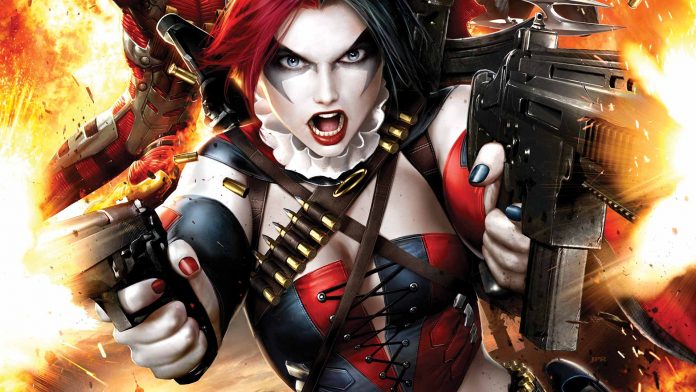The Incredibly Thorough History of Harley Quinn: The Suicide Squad’s Psychotic, Harlequin-Themed Angel of Erratic, Extravagant Death!
It’s hard to imagine, but one of the unlikeliest characters in DC history has essentially (and arguably) become the company’s fourth tent pole. For decades, DC has existed on the back of its heroic trinity- Superman, Batman, and Wonder Woman. But in the last quarter century, another colorful character has risen the DC ranks and has become one of the most marketable, beloved, and wearable DCU icons.

And this bad girl is no do-gooder; she’s a sometimes naughty, sometimes nice, pinup-inspired bad girl. She’s the Joker’s best girl, Gotham’s most infamous daughter, and the heads of the Hot Topic Corporation probably thank their lucky stars for her on an hourly basis. But through all this popularity, Harley has yet to make a film appearance. What’s the mattah, Chris Nolan? Didn’t you want to give this Harley a test drive?
But that’s all going to change as Margot Robbie is about to bring Harley Quinn to cinematic life for the first time in the upcoming Suicide Squad film, and from the looks of things, it seems like good ‘ol Harley girl may just steal the show.
And if there’s ever a character that deserves film success, it’s Harley. I mean, she is arguably the most popular mainstream comic character created in the past twenty-five years (go on, name a more popular character that doesn’t have the surname Grimes). She has conquered animation, comics, the world of cosplay, and video games. She has become the symbol of a generation and an iconic female character in an industry that has a hard time producing iconic female characters. But through all this success, can you imagine that one of the most important characters in the world of Batman didn’t even appear for the first time in a comic? That’s right, our girl Harley is a crossover success for the ages, and before Suicide Squad hits theaters in August, let’s brush up on the history of Harley Quinn because this clown is going places.
Animation Domination!
Think about the great characters created by Warner Brothers Animation over the decades. Bugs Bunny, Daffy Duck, Porky Pig, Tweety Bird, Sylvester the Cat, Road Runner, Wile. E Coyote, Yosemite Sam, Foghorn Leghorn, Pepe LePew, Elmer Fudd, Speedy Gonzales, and my personal favorite, Beaky Buzzard (NONONONONO). Add one more to the list- our lady of chaos, Harley Quinn.

You see, when Paul Dini, Bruce Timm, Alan Burnett, and the rest of the legendary creators of Batman: The Animated Series were bringing the world of Batman to life in animation, they had plenty of heroes, villains, and supporting characters to choose from. This was around 1992, and Batmania was running wild. Both of the live-action Tim Burton films had already made huge bank for Warner Brothers and the WB wanted to continue to exploit the Bat world. The result was probably the most important and influential comic book TV adaptation of all time as Timm, Dini, Burnett, and the rest presented the familiar heroes and villains of Gotham City to kids and adults hungry for more Bat action.
For villains, the creators of this immortal cartoon series looked to all eras of Bat lore. They presented the most archetypal Bat villains in Joker, Penguin, Catwoman and the Riddler. They introduced many Bat foes that had never appeared on TV before like Two-Face, Scarecrow, Poison Ivy, Ra’s Al Ghul, and Talia. They did some deep Bat cuts and reimagined characters in ways that would forever redefine them across media like Mister Freeze and Clayface, and they even created a few new villains like the Red Claw, Baby Doll, and Roxy Rocket. But perhaps Dini, Timm, and Burnett’s greatest creation was a standout, Brooklyn-accented clown that was only supposed to be a minor supporting character.
Every good villain has a gang, so Dini and company created a bunch of goons for their animated Joker. They figured every good gangster needs a moll, so they gave him one, a motley-clad, cheesecake pinup that just popped off the page. According to Bat lore, Dini came up with the name and the idea and Timm came up with the visual design and a legend was born. But like many second banana characters, Harley could have faded into minion obscurity. Thankfully, when this pancake makeup-wearing beauty first opened her mouth, fans all over the world lost their collective hearts to this jester-themed bad girl.
Harley Quinn was voiced by Arleen Sorkin, an accomplished screen, stage, and voice actor, and when Harley spoke, fans listened. Fans couldn’t get enough of this tough girl’s East Coast twang as every line written for Harley popped. She was dangerous, sultry, naughty, and hilarious. It’s hard to imagine anything adding to the legend of the Joker. I mean, the Clown Prince of Crime is probably the most perfect super-villain ever created, but that’s exactly what Harley Quinn did, adding a slapstick foil and confidant to her Mr. J. It was a match made in hell as Joker and Harley became the Bonnie and Clyde of the super-villain scene.
Harley first appeared in the 1992 episode of Batman: The Animated Series entitled “Joker’s Favor.” it was supposed to be just a walk-on role as Harley jumps out of a cake in the Joker’s bid to take James Gordon and the GCPD hostage. Paul Dini was old friends with Sorkin and based much of Quinn’s personality on the actress. Harley leaped out of that cake and into the hearts and minds of fans everywhere. Soon after her debut, Harley became a beloved part of the unfolding B:TAS. So much so that she ceased being a bit player and became a Bat Rogue shot-caller in her own right.
BFFs
Harley began to become a regular feature on the animated Batman. In the episode “Harlequinade,” Harley helps Batman track down Joker, who is in possession of a nuclear device (yikes). Harley betrays Batman but ultimately turns on the Joker when her puddin’ reveals that he was going to set off the device without coming back for Harley or their pet hyenas. In “Harley’s Holiday,” Quinn attempts to go straight after getting out of prison but ends up on the run after she is accused of stealing a dress. The episode is pure slapstick hijinks with a rather moving ending that sees a very charitable Batman help Harley out of her jam.
But if one is talking about important B:TAS Harley episodes, one has to mention “Harley & Ivy.” Now, Harley Quinn fundamentally changed both the legends of Batman and the Joker, but she also changed the character of Poison Ivy as well. In “Harley & Ivy,” the two female rogues team up as they both must outrun the law, Batman, and the Joker. Along the way, the two become the DCU’s version of Thelma and Louise as they stay one step ahead of all their pursuers. Ivy helps Harley find a sense of sisterhood and independence while Harley gifts Ivy with a sense of fun and friendship.
This bond between Harley and Ivy would define both characters for the next generation as the two united in comics and animation again and again. This friendship would continue in the episode “Girls’ Night Out,” where the two were joined by Superman foe Live Wire to take on Supergirl and Batgirl. With all due respect to Barbara and Kara, it can be said that Poison Ivy and Harley possess the most enduring female friendship in the DC Universe, and this bond began in Batman: The Animated Series, the very same show that presented Harley Quinn to the world.
Four Color Sweetheart
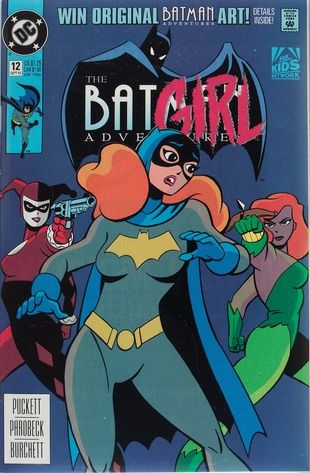
Speaking of comics, the awesomeness of Harley Quinn could not be contained by the world of animation. Soon after she created a storm of fan love on TV, Harley Quinn appeared in a DC Comic for the first time. In The Batman Adventures #12 (September 1993) by writer Kelley Puckett and artist Mike Parobeck, Harley made her print debut.
Batman Adventures was set in the world of Batman: The Animated Series and this particular issue saw Harley team up with Catwoman and Poison Ivy to take on Batgirl. This particular issue demands huge bucks on the secondary comic book market even if it doesn’t take place in DC continuity. “Batman Adventures” was the only place Harley’s growing following could follow their puddin’ in comic form, but soon, DC would deliver an in continuity Harley and the DC Universe would never be the same.
Mad Love
Before Harley could arrive to the DCU proper, there was one more step in her comic book evolution. In 1994, Dini and Timm produced The Batman Adventures: Mad Love, a detailed look into the origins of Harley Quinn. Harley’s disturbing history had yet to be revealed on TV, but her two daddies, Dini and Timm, related the tragic tale of how Harley became the Joker’s best girl in comics.
You see, Harley was once Harleen Quinzel, gifted psychologist and the newest staff doctor at Arkham Asylum. Harleen is assigned to the Joker and is shocked to learn that the infamous psychopath was actually a victim of child abuse, a cycle that continues at the hands of Batman. Harleen is present every time Batman brings in a bleeding and broken Joker back to Arkham and she feels profound sympathy for the funny man she sees as the ultimate victim.
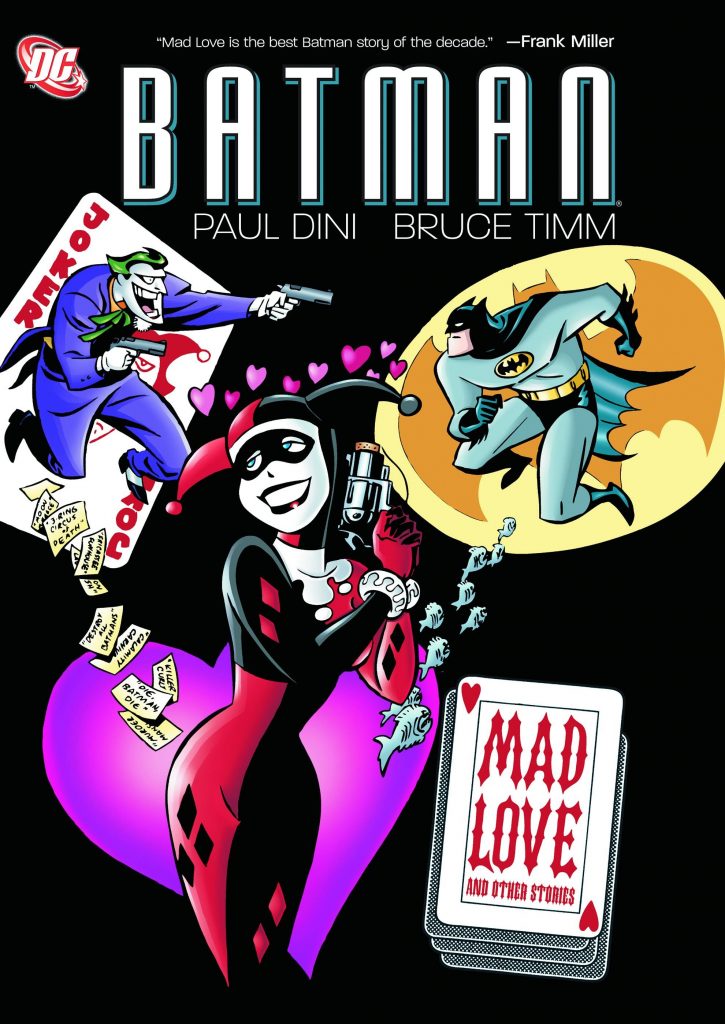
Of course, the Joker is playing her like a fiddle and through this tale, Dini and Timm show the world the depths of the Joker’s abilities to manipulate any mind, including that of a master psychoanalyst. This story also shows the modern day relationship between Harley and Joker, a relationship marred by psychological abuse and domestic violence. The book makes the reader really care for Harley as she is shown as just another victim of the Joker’s constant game.
By the end of the story, Harley helps Batman defeat the Joker and even almost kills Batman in the process. After “Mad Love,” very few comics or animated tales would show Joker and Harley together as the two transitioned into the ex-zone. Now, Harley is trying to get over the abusive relationship and strike out on her own as a criminal force in Gotham City. “Mad Love” won “Best Single Issue” at the 1994 Eisner Awards and was adapted in the 1999 The New Batman Adventures animated series.
The cartoon adaptation did not shy away from the inherent violence between Joker and Harley and was just as effective as the graphic novel. After “Mad Love,” Harley’s genius and her once promising medical career became major aspects of the character and added an extra layer to a character that had already grown so narratively rich.
DC’s Leading Lady
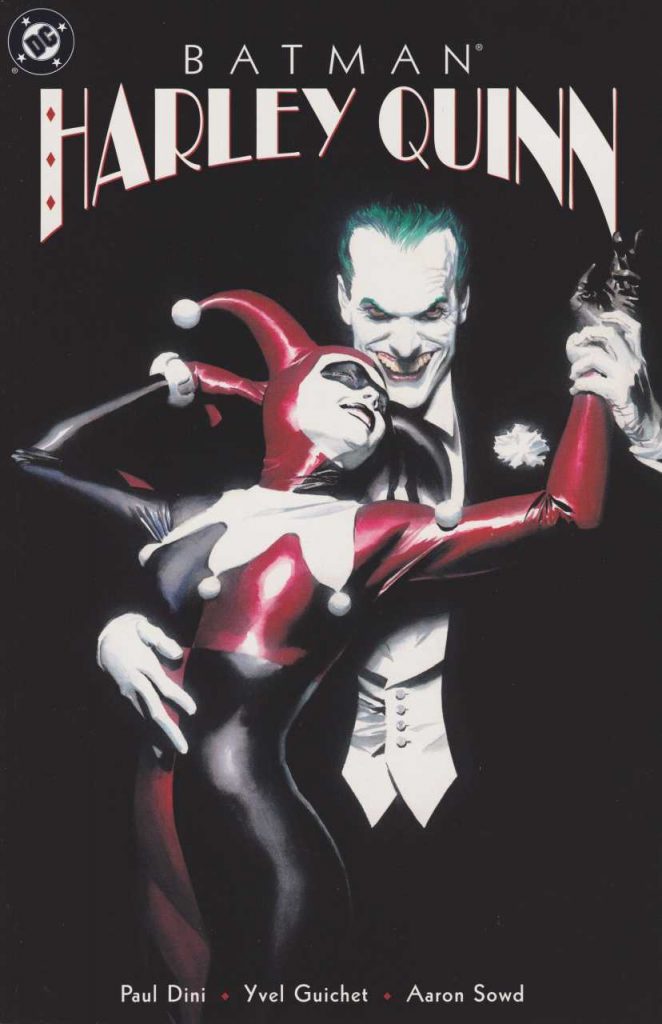
With her origin in place, it was time for Harley Quinn to join the DC Universe. In Batman: Harley Quinn #1 (October 1999), Dini and artist Yvel Guichet (all under one of the most iconic Alex Ross covers you will ever see) birthed Harley Quinn into the DC Universe. This story was set during “No Man’s Land,” an event that saw most of Gotham City destroyed by an earthquake. During the natural disaster, Harley was a new orderly working at Arkham Asylum. She began a furtive romance with the Joker but was injured during the quake. She donned her familiar motley costume and joined the chaos of “No Man’s Land.”
This issue presents Harley’s first in-continuity comic book meeting with Joker, Poison Ivy, and Batman and defines these characters’ relationships going forward. At first, Joker rejects Harley, but when Quinn gets the better of her puddin’, Joker uses that old sly charm to win her back. Harley blows up an abandoned amusement park to kill Batman, but of course he escapes. And even though Batman lives to fight another day, his world has changed, not only because Gotham was devastated by an earthquake, but because the human natural disaster Harley Quinn was now added to the comic book chaos of Batman’s world. Harley arrived in the DC Universe fully formed thanks to Dini and after this one shot, all the allegiances and rivalries were in place to move Harley to the next level of character success.
Solo Act
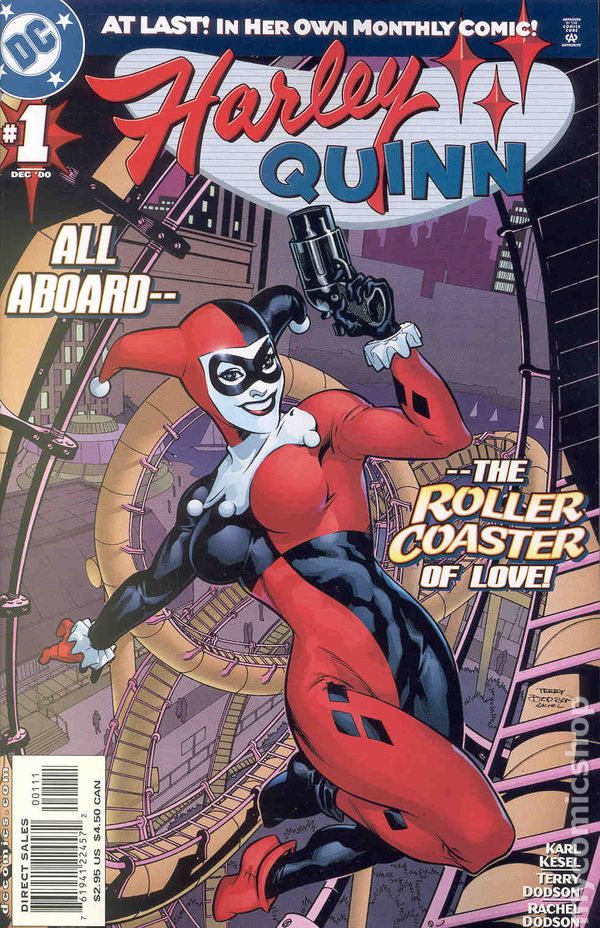
Fans that fell in love with the animated Harley transferred that love to the comic page and DC’s black and red clown was a hit, so much so that in 2001, DC gave Ms. Quinn her own comic. Now, back in the early part of the 21st century, it was quite rare for a female villain to be granted her own series; Catwoman pretty much cornered the market on female baddies popular enough to carry their own title, but Harley reached this rarified air.
In its two year run, Harley Quinn was brought to fans by the creative talents of Karl Kesel, Terry Dodson, A.J. Lieberman, and Mike Huddleston. The series started out pretty strong both critically and commercially, but as the series grinded on, Harley lost her momentum. Writer Karel Kesel in particular was able to get into Quinn’s head and delivers some impactful stores. Some of the more memorable moments saw Quinn starting her own gang, picking up and moving to Metropolis with Poison Ivy, dying, and being resurrected. At this time, Harley even participated in her first mega crossover event, “Our Worlds at War.” This was a Superman-centric alien invasion story that spanned the breadth of the DC Universe and Harley was right in the middle of it. Our girl had come so far.
All the Psycho Ladies, All the Psycho Ladies
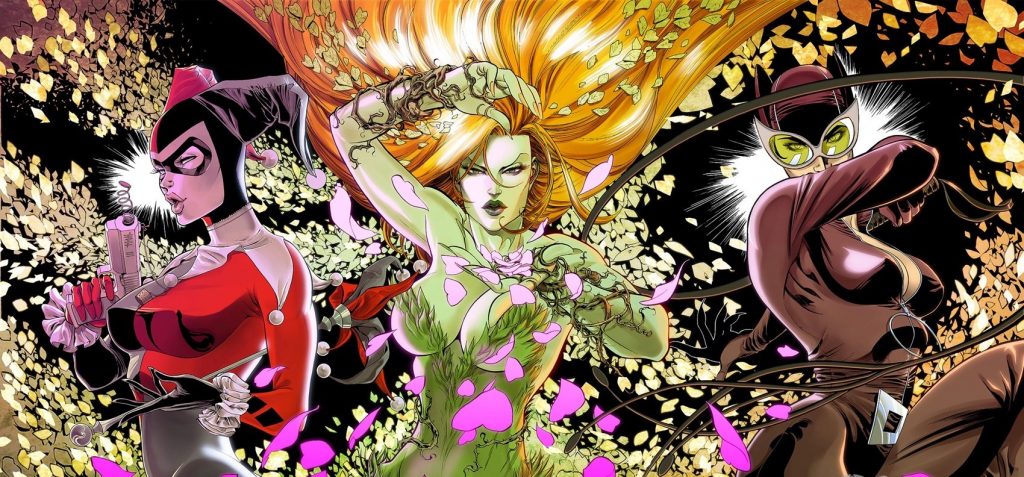
As Harley began to appear more and more in the DC Universe, it seemed like she was never that far from her creator- Paul Dini. Dini inserted her into his run on Detective Comics whenever he could and also found a home for Harley in Gotham City Sirens, a new team book featuring Quinn, her old pal Ivy, and Catwoman. Many fans adored the twisted sisters of Gotham City as they became a trio of anti-heroes. Many people of all genders liked the interplay between these classic villains, especially under Dini. Gotham City Sirens didn’t last long, but it added Catwoman to the Harley mythos, strengthening the sorority of female Gotham villains that had each other’s back through thick and thin.
Gamer Grrrl
Harley Quinn became a beloved DC icon when she was introduced in a medium other than comics. It should come as no surprise that this multi-media superstar took her next evolutionary step in a place other than DC publishing. A very different Harley (still voiced by Sorkin, though- and later DC voice-acting vet Tara Strong) took the world of gaming by storm when she appeared in the popular Arkham series of games.
Gone was Harley’s famous jester outfit, replaced by a more Gothic, adult Harley Quinn. This video game Harley just oozed fetishism and while this upset some purists, it also attracted legions of new fans to Quinn. She may have looked different, but this Harley was still as sick and broken as her comic and animated self. She just wasn’t so cutesy anymore. This new Harley began to replace the old motley-clad jester on the cosplay circuit and DC Comics took notice of this black and red paradigm shift.
New 52
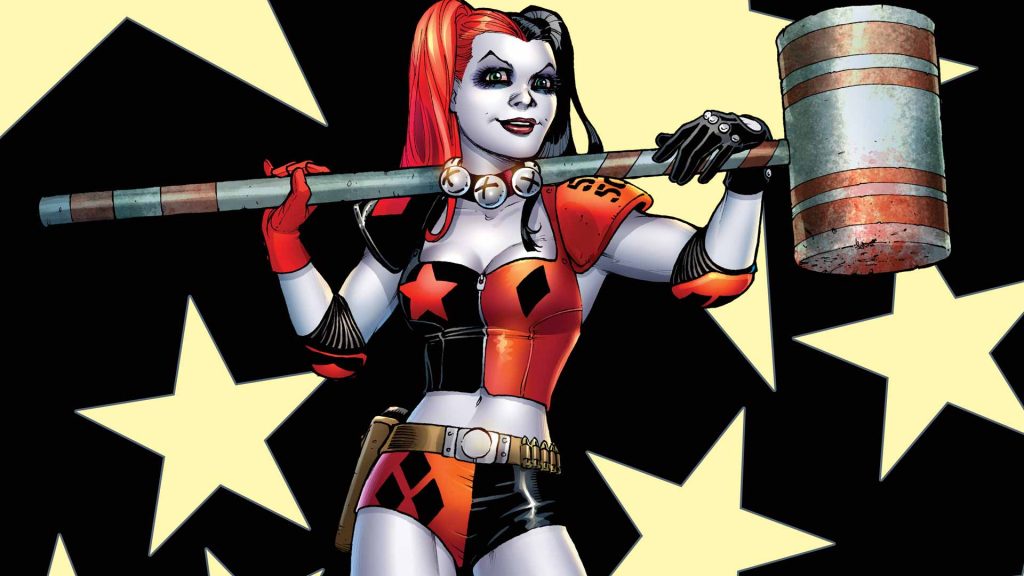
When DC relaunched its universe, a whole new Harley Quinn came along for the ride. This new Harley, borrowing her look from the Arkham games, was more anti-hero than ever. Gone was the wide-eyed innocence of the old school Quinn, replaced by a worldly Quinn. It seems that Margot Robbie is borrowing her look and attitude from this New 52 Harley Quinn.
Suicide Solution
Of course, this new Quinn was introduced not in Batman, but in a title that has become synonymous with the Clown Princess. Before the New 52, Harley Quinn was not connected to the Suicide Squad at all. She never participated in the Squad’s long running title, and she never found herself wearing one of Amanda Waller’s famed bomb collars. But when the New 52 hit, Harley was now a member of the Squad. Since the new Suicide Squad arrived, Quinn has been as big a part of the team of villains as Squad mainstays Deadshot and Captain Boomerang. Now, it’s kind of impossible to imagine the Squad without its pony tailed miscreant. Being part of the Suicide Squad has taken Harley out of Gotham and into the wider DCU and has allowed her to take part in a film project that will soon introduce her to the world.
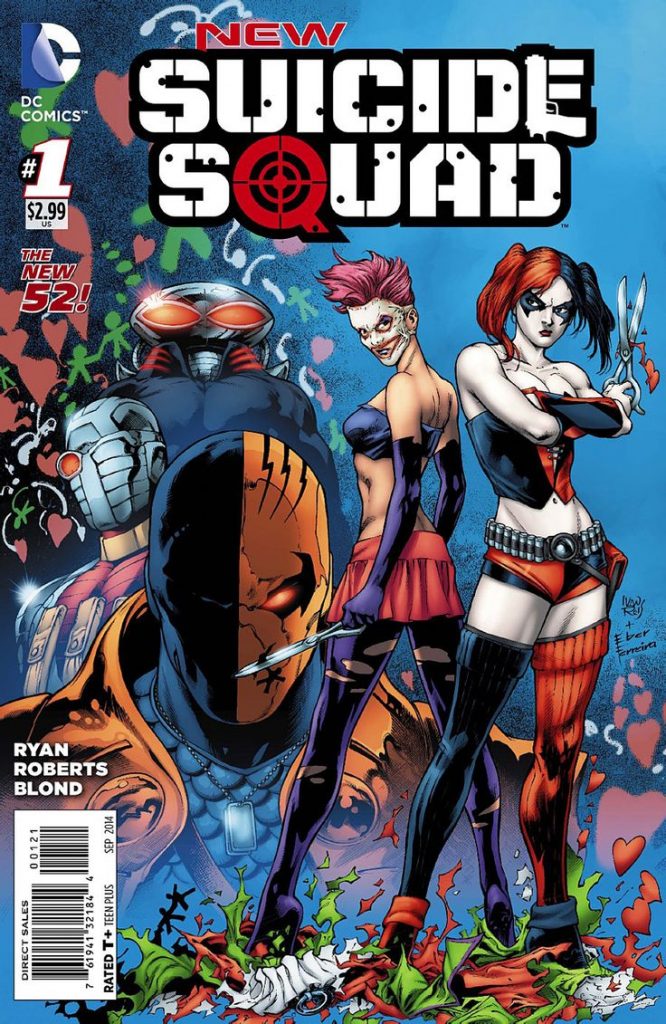
Harley’s Modern Day Mom and Dad
Bruce Timm and Paul Dini may have given birth to Harleen Quinzel, but one cannot discount Harley’s modern day creative parents- Amanda Conner and Jimmy Palmiotti. In 2013, just a few years into the New 52, DC announced a new Harley Quinn title by Conner and Palmiotti. What the husband and wife creative team did was combine the old school animated Harley with the New 52 Harley and found the right balance between innocence and mayhem. This new solo Harley was now a sort of hero, free from Gotham and the Joker. Harley became the protector of her own block in Brooklyn and even joined a roller derby team. This new take on Quinn was a massive hit and many spinoffs and miniseries followed. Fans just couldn’t get enough of this new Harley as she had become one of DC’s bestselling characters. So much so that DC now seemed to exist on a Trinity plus one- Superman, Batman, Wonder Woman, and our best girl- Harley Quinn, all thanks to the creative brilliance of Conner and Palmiotti.
The Future
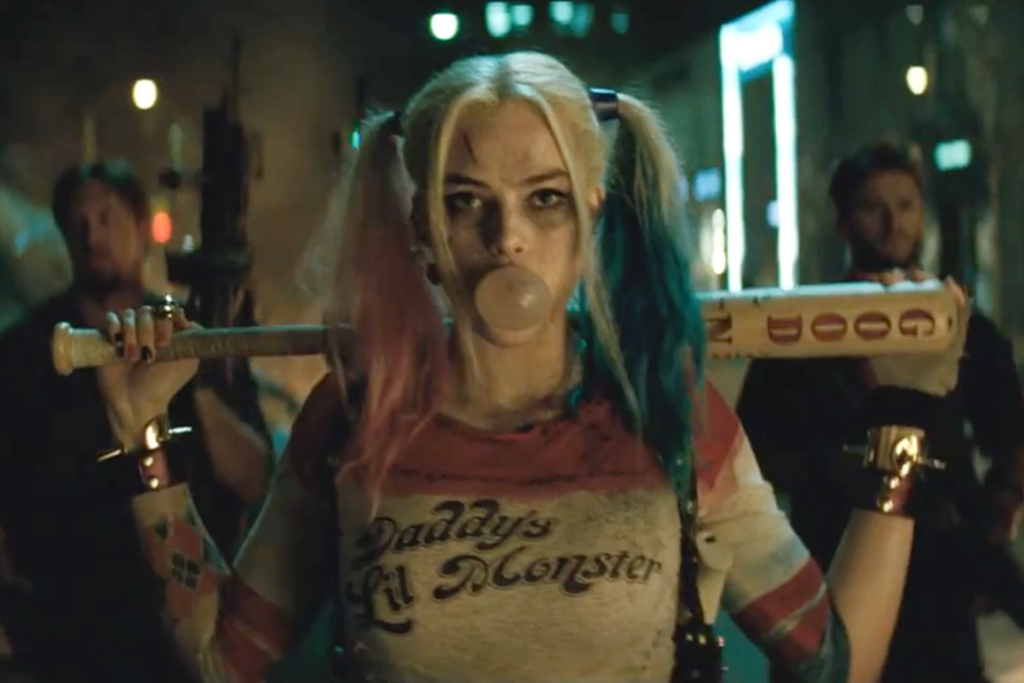
Harley has yet to pop up in the new DC Rebirth universe, but she will. Harley is scheduled for her own Rebirth special and will be given a bi-weekly title by Conner and Palmiotti. Of course, I’m sure many miniseries and specials will follow as Quinn’s popularity grows thanks to her first film appearance. And it looks like there is more celluloid Harley on the way. Recently, DC Entertainment announced that it is working on a solo Harley Quinn film to be produced by Margot Robbie. Not bad for a girl who was only supposed to be a bit player on a cartoon. Soon, the world will belong to Harley- but really, thanks to Dini, Timm, Sorkin, DC, Conner, and Palmiotti, Harley Quinn has become the premiere bad girl in all of comics. Ain’t that right, puddin’?

